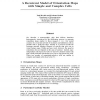Free Online Productivity Tools
i2Speak
i2Symbol
i2OCR
iTex2Img
iWeb2Print
iWeb2Shot
i2Type
iPdf2Split
iPdf2Merge
i2Bopomofo
i2Arabic
i2Style
i2Image
i2PDF
iLatex2Rtf
Sci2ools
NIPS
2003
2003
A Recurrent Model of Orientation Maps with Simple and Complex Cells
We describe a neuromorphic chip that utilizes transistor heterogeneity, introduced by the fabrication process, to generate orientation maps similar to those imaged in vivo. Our model consists of a recurrent network of excitatory and inhibitory cells in parallel with a push-pull stage. Similar to a previous model the recurrent network displays hotspots of activity that give rise to visual feature maps. Unlike previous work, however, the map for orientation does not depend on the sign of contrast. Instead, signindependent cells driven by both ON and OFF channels anchor the map, while push-pull interactions give rise to sign-preserving cells. These two groups of orientation-selective cells are similar to
| Added | 31 Oct 2010 |
| Updated | 31 Oct 2010 |
| Type | Conference |
| Year | 2003 |
| Where | NIPS |
| Authors | Paul Merolla, Kwabena Boahen |
Comments (0)

